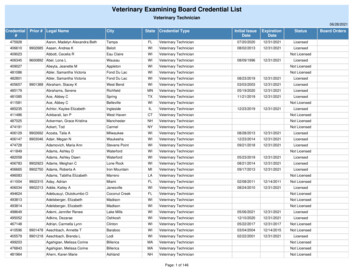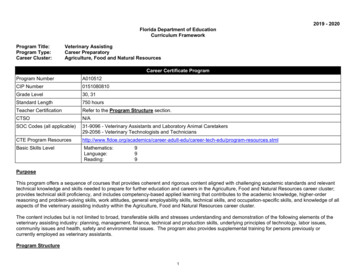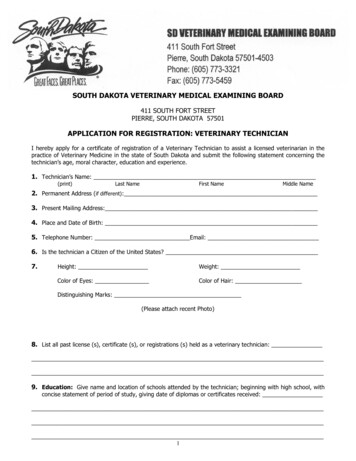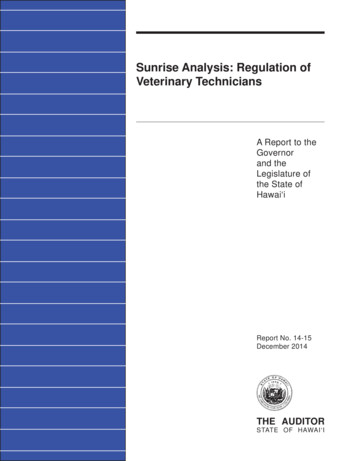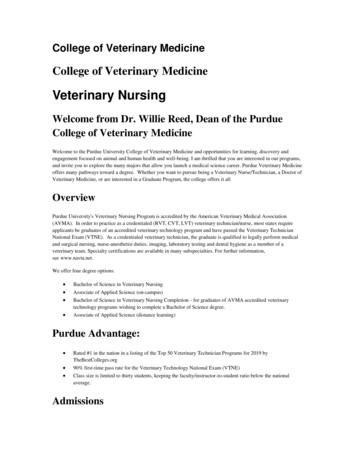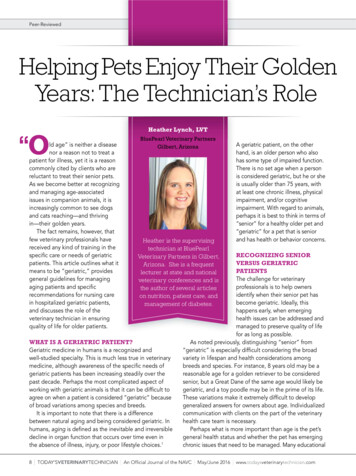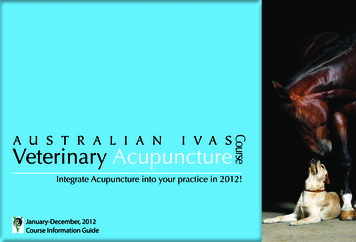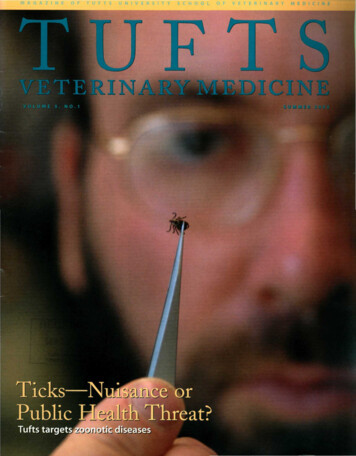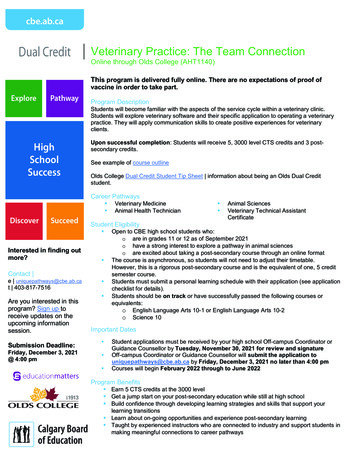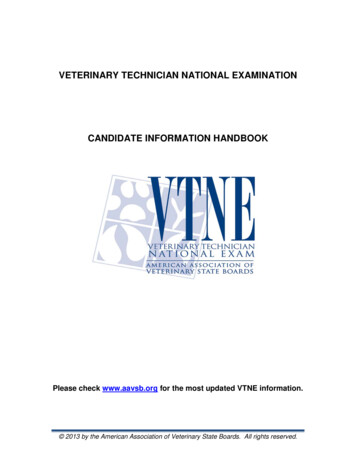
Transcription
VETERINARY TECHNICIAN NATIONAL EXAMINATIONCANDIDATE INFORMATION HANDBOOKPlease check www.aavsb.org for the most updated VTNE information. 2013 by the American Association of Veterinary State Boards. All rights reserved.
P a g e 1Table of ContentsIntroduction. 2About the AAVSB . 2About the VTNE . 2Purpose . 2Development . 2Content . 3Administration . 4Exam Security . 4Preparing for the VTNE. 5Exam Application, Eligibility and Scheduling . 5Eligibility . 6Applying to take the VTNE. 6Special Accommodation Requests . 7Name, Mailing Address or Email Address Changes . 7Choosing a Time and Place to Take the Exam . 7Confirming Examination Appointments . 8Rescheduling Examination Appointments and Additional Fees. 8Withdrawing an Application within the Allowed Timeframe. 9No-Shows. 9Inclement Weather/Local or National Emergencies . 10The Prometric Testing Center. 11Taking the VTNE by Computer . 11VTNE Scores . 12At the Testing Center. 12Score Report . 12Additional Score Review . 13Score Transfer. 13Contact Information . 14Appendices . 15Appendix 1A . 16Appendix 1B. 20 2013 by the American Association of Veterinary State Boards. All rights reserved.
P a g e 2IntroductionThis candidate handbook is designed to be the main source of information for thoseapplying to take the Veterinary Technician National Examination (VTNE). Thehandbook contains the essential information regarding eligibility requirements,application procedures and fees, appointment scheduling, examination content, and otherimportant information and guidelines related to the examination.The AAVSB recommends that candidates carefully read and understand all of the topicscovered in this handbook. Candidates may also consult the AAVSB website(www.aavsb.org) for additional information about the VTNE.About the AAVSBThe American Association of Veterinary State Boards (AAVSB) is a 501(c) ( 3),nonprofit corporation dedicated to its overall objective and mission which is to providequality resources for veterinary regulatory agencies, professionals, and allied groups inthe interest of public protection.The VTNE is one of the AAVSB’s major programs. The AAVSB owns the examinationand oversees its administration and development.About the VTNEPurposeThe VTNE is designed and used to evaluate entry-level veterinary technicians’competency to practice and be credentialed and is constantly updated, reviewed andreevaluated by highly-qualified item writers. With the AAVSB’s commitment toexamination development, the VTNE remains a valid tool, useful in the evaluation ofcandidates for credentialing. Many jurisdictions require a passing score on the VTNE asone criterion for credentialing.The VTNE program has three main objectives: Provide examination services to assist the state and provincial regulatory boards intheir mission of protecting the public by ensuring applicants demonstrate a specificlevel of knowledge and skills before entering the profession as practitioners. Contribute to the development of an improved relationship between knowledge andprofessional practice. Provide a common standard for the evaluation of candidates that is comparable acrossjurisdictions.DevelopmentThe VTNE is a multiple-choice examination prepared under a contractual agreement 2013 by the American Association of Veterinary State Boards. All rights reserved.
P a g e 3between the AAVSB and the Professional Examination Service (ProExam).The AAVSB is responsible for the annual development and validation of the VTNE. TheVTNE Committee, under guidance provided by the AAVSB and ProExam, ensures thatthe VTNE reflects current practice in the field of veterinary technology.The VTNE Committee is comprised of representatives from: Association of Veterinary Technician Educators (AVTE) Canadian Association of Animal Health Technologists and Technicians(CAAHTT) Committee on Veterinary Technician Education and Activities (CVTEA) National Association of Veterinary Technicians in America (NAVTA) Veterinarians and veterinary technicians in private practice and educationQuestions for the VTNE are written by veterinarians and veterinary technicians whorepresent all aspects of the profession, including educators, practitioners, members ofspecialty boards, and the national practice associations. Each newly written question isreviewed and validated by at least three experts in the field of veterinarymedicine/technology for content relevance, importance, difficulty, and correctness.These questions are then reviewed and validated by psychometricians and editors toensure conformity to psychometric principles and to rules of grammar and style.Once a question is accepted following this validation process, it is placed into acomputerized item-banking system. The questions for potential use on the VTNE areselected by the computer in accordance with the practice-based examination blueprint(test specifications, see Appendices 1A and 1B). The VTNE Committee then reviews thecomputer-generated test, item by item, making changes and substitutions as necessary.Following this review, the finished examination is prepared by ProExam.ContentThe VTNE consists of 150 multiple-choice operational questions and 20 multiple-choicepilot questions derived from the test specifications. The candidate’s score on the VTNEis based on the candidate’s responses to 150 operational questions; the remaining 20 pilotquestions embedded in the test will not count towards the candidate’s score. The pilotquestions will be used in constructing future examinations. In the examination, the pilotquestions are not marked any differently from the operational questions; thus candidateswill not be able to distinguish a pilot question from an operational question.The VTNE examination covers: Nine (9) primary areas of responsibility (Domains) Thirty-eight (38) Task Area Statements Fifty (50) Knowledge Area StatementsThe veterinary technology domains of practice are the major areas of responsibilitydeemed essential for an entry-level veterinary technician. The task area statements arespecific goal directed actions undertaken by an entry-level veterinary technician within aparticular veterinary technology domain of practice. The knowledge area statements areobtained from a job analysis study completed by the AAVSB and ProExam every 5-7 2013 by the American Association of Veterinary State Boards. All rights reserved.
P a g e 4years. The last job analysis study was completed in 2012. The knowledge area statementsconsist of knowledge used across the seven domains of veterinary technician practice. Acomplete list of the veterinary technology practice domains and task and knowledge areastatements are presented within Appendices 1A and 1B.AdministrationThe computer-based VTNE is administered by the AAVSBthrough Prometric at testing centers throughout the U.Sand Canada. Please see www.aavsb.org for currentinformation about testing windows and applicationdeadlines.VTNE Testing WindowsMarch 15 – April 15July 15 – August 15November 15 – December 15Exam SecurityThe VTNE is the property of the AAVSB and is protected by federal copyright laws. It isa violation of those laws, and thus illegal, to share any information whatsoever about anyVTNE question. In particular, sharing information about a VTNE question recalled frommemory or asking someone who has taken the VTNE to share such information is illegal.Below is the Candidate Agreement which candidates must agree to in order to completethe examination application. During the online VTNE application, candidates will viewan exam security advisory video prior to the Candidate Agreement. Candidates will alsosee this agreement on the examination application and on the computer screen at thePrometric Testing Center.I acknowledge and understand that the Veterinary Technician National Examination (VTNE) isowned by the American Association of Veterinary State Boards (AAVSB) and is protected underapplicable intellectual property rights, including copyright protections. I further acknowledgeand understand that the VTNE is a high stakes examination used by licensure and certificationentities as one component of determining eligibility for a credential. I affirm that I am sitting forthe VTNE solely for the purpose of seeking a credential.Based upon the significance of the VTNE and acknowledging the legal rights, ownership andprotections of the examination in AAVSB, I hereby agree that, with the exception of previousVTNE administrations, I have not had access to any part of VTNE examination questions and/orresponses prior to this administration of the VTNE and that my responses to the questions on theVTNE will be based upon my knowledge, skills, and abilities, and not prior exposure to examquestions.I further acknowledge and understand that I will not remove VTNE examination questions fromthe test center in any manner, including memorization, electronic downloads, recording devices,copying, or through any other means and I will not distribute or discuss any questions to anypersons and in any manner whatsoever either before, during, and/or after taking the VTNE. Thisincludes through my own personal social media channels, the official AAVSB social mediachannels, or other social media channels.I understand that during the examination, including breaks, I may not communicate with othercandidates, refer to any materials other than those provided to me by the testing center, or assistor obtain assistance from any person. 2013 by the American Association of Veterinary State Boards. All rights reserved.
P a g e 5I understand and agree to the security and confidentiality of the VTNE and acknowledge thatAAVSB has the right to investigate any alleged wrongdoing related to my administration of theVTNE and to take action to protect the integrity of the examination and the credential process,including but not limited to withholding or invalidating my examination score and refusing toallow access to future VTNE administrations.Preparing for the VTNEIn order to prepare for the VTNE, candidates may wish to review the major areas to betested. In addition, the AAVSB provides two online practice tests, which assesscandidates’ strengths and weaknesses in each of the nine content areas of the VTNE. Thequestions on the practice tests are similar to the test questions on the actual examinationand the passing score represents a similar standard to that of the actual examination.Performance on the practice tests provides an indication of test readiness, but does notguarantee a similar result on the VTNE.The VTNE Practice Tests are presented online, and the fee is 45 per use. Forinformation on the VTNE Practice Test, visit www.aavsb.org. To access the practicetests, visit www.testrac.com/aavsb/.Exam Application, Eligibility and SchedulingThe AAVSB does not license, certify, or registerveterinary technicians.The information provided is for the examination process only. To apply for acredential, contact the state or provincial agency in the jurisdiction where you areplanning to work.To take the VTNE, candidates must apply and pay for the exam and candidates mustapply for eligibility to take the exam.1. Eligibility: All candidates seeking to take the VTNE must be eligible to take theexam. The requirements for eligibility vary by the state or province throughwhich a candidate wishes to take the exam. Candidates can refer to the Board andAgency Directory on the AAVSB website, www.aavsb.org, for eligibilityrequirements for your specific state or province.2. Applying: Apply online to take the exam with the AAVSB. Candidates pay forthe VTNE exam when the online VTNE application is submitted.3. Making the Appointment: After the application and eligibility have beenprocessed, candidates will be sent an Authorization-to-Test (ATT) letter via emailexplaining how to make an examination appointment at a Prometric TestingCenter. The choice of the Prometric Testing Center will determine the date, time,and location of the individual’s exam. 2013 by the American Association of Veterinary State Boards. All rights reserved.
P a g e 6It is best to keep all exam information received from the AAVSB, ProExam andPrometric in one place and accessible. All of these organizations will be involved atdifferent times in the exam application process.Keep in mind for each testing window, there are deadlines for submitting an onlineVTNE application and documentation. These deadlines are approximately 30 days priorto the start of the testing window. Some states and provinces have earlier state credentialapplication deadlines than the online VTNE application and documentation deadline andcandidates must meet those deadlines, as well.Testing WindowsMarch 15 – April 15July 15 – August 15November 15 – December 15Application and Document DeadlineFebruary 15June 15October 15EligibilityEligibility to take the VTNE will be confirmed after submission of the online VTNEapplication to the AAVSB and before an Authorization-to-Test (ATT) letter is sent viaemail. The eligibility review will be conducted by either the AAVSB or by theregulatory board indicated on the application. Please visit the AAVSB website atwww.aavsb.org for the most up-to-date information on where to send documentation.The AAVSB requires that candidates be a graduate of an American Veterinary MedicalAssociation (AVMA) or Canadian Veterinary Medical Association (CVMA) accreditedveterinary technology program or a program approved by the regulatory board of thejurisdiction that the candidates indicate on their applications.Applying to take the VTNEVisit www.aavsb.org and click the link provided to apply for the VTNE. Whencompleting the online VTNE application, the candidate’s name should be entered exactlyas it appears on the ID to be used at the testing center (see ID information in the boxbelow). After completing the application, print a copy of the receipt page. Candidatesmust create a login for a MyAAVSB account at the time of your application. Thisaccount allows candidates to login and update personal information, ask questions, checkstatus of the application, and review the official score report when available. Candidateswill not be able to access the MyAAVSB account until the application has beenprocessed. Check the AAVSB’s website for updates on processing times.The VTNE examination fee includes the Prometric seat fee. Please see www.aavsb.orgfor the current exam fee. The AAVSB accepts Visa, MasterCard, and American Express.The ONLY acceptable ID:A government issued (passport, driver’s license, or national or military ID) inofficial language where testing center is located. Must be current—expired not accepted! Must include photo Name must match all exam application paperwork 2013 by the American Association of Veterinary State Boards. All rights reserved.
P a g e 7Special Accommodation RequestsThe AAVSB is committed to the principle of testing individuals in a manner that willyield valid and reliable examination results. In some instances, the examinationadministration procedures may need to be modified to provide reasonableaccommodations for candidates with disabilities. If you have a documented disabilitycovered under the U.S. Americans with Disabilities Act Amendments Act of 2008(ADAAA) or the Canadian Human Rights Act, first apply for the VTNE through theAAVSB website (www.aavsb.org). Candidates needing special accommodations whocannot use the on-line application should email vettech@aavsb.org or call 1-877-6988482, ext. 228 to make other arrangements for submitting an application.Candidates must complete the documentation required by either the AAVSB or the stateor province through which candidates are registering by the respective applicationdeadlines.For those states/provinces that the AAVSB reviews eligibility and specialaccommodation requests, candidates need to submit the Special AccommodationApplication accessed on the AAVSB website along with supporting documentation.For those states/provinces that review eligibility for the VTNE, candidates can refer tothe Board and Agency Directory for special accommodations requirements.Name, Mailing Address or Email Address ChangesIf your name changes any time after applying to take the exam, please contact AAVSB assoon as possible in writing via vettech@aavsb.org with the information change. Pleaseinclude the name as submitted on the online VTNE application, the new name as itappears on the proper ID, the telephone number and date of birth. Please note: the nameon the ID that you present at the testing center must match yourapplication/registration documentation on your emailed Authorization-to-Test(ATT) letter.Changes to mailing or email addresses must be made by logging into MyAAVSB. Pleasenote: AAVSB must have a current and unique email address on file as allcommunication regarding the exam process is sent via email, including theAuthorization-to-Test (ATT) letter and notifications regarding scores.Choosing a Time and Place to Take the ExamUpon completion of the application and approval of eligibility an Authorization-to-Test(ATT) letter will be sent by email from ProExam.Please print and save the ATT letter as it explains scheduling VTNE appointments,provides contact information for confirming or changing appointments, and listsitems to bring on the day of the exam.The VTNE is offered on a networked computer at a Prometric Testing Center. There are 2013 by the American Association of Veterinary State Boards. All rights reserved.
P a g e 8over 250 testing centers throughout the U.S. and Canada. Visit the Prometric website atwww.prometric.com/aavsb to locate a convenient testing site prior to scheduling anappointment. Most testing centers are open Monday through Saturday.As the ATT letter explains, examination appointments must be scheduled in one of thefollowing ways: Visiting Prometric’s website at www.prometric.com/aavsb to schedule anappointment online; the website scheduling feature is accessible 24 hours a dayORCalling 1-800-869-1100 which is open Monday through Friday from 8:00am –8:00pm Eastern Time.For scheduling an examination appointment with special accommodations, please refer tothe ATT letter for specific instructions.The Eligibility or Candidate ID number is on the first page of the ATT letter so have theletter available when scheduling a VTNE appointment. An Appointment ConfirmationNumber will be sent to the email address on record. This number is required to confirm,reschedule, or cancel an appointment.Candidates who wait to schedule an appointment within 48 hours of the close of thetesting window will not be able to use the online option for scheduling appointments.The only option for scheduling within 48 hours of the close of the testing window is tocall 1-800-869-1100. Note that a desirable time and location may not be available ifscheduling is delayed.For those candidates scheduling an examination appointment with specialaccommodations please be advised to schedule the examination appointment as soon aspossible.Want the best time and date?AAVSB recommends that all appointments be scheduled upon receipt of the ATTletter to help assure availability of a desirable appointment time and location.Confirming Examination AppointmentsIt is recommended that examination appointments be confirmed within 48 hours of beingmade. Appointments can be confirmed online at www.prometric.com/aavsb or by phoneat 1-800-869-1100.Rescheduling Examination Appointments and Additional FeesTo change an exam date or time within the same exam window, Prometric must becontacted at least 3 days prior to your appointment by using the Reschedule/Canceloption on the website (www.prometric.com/aavsb) or by calling Prometric at 1-800-8691100. The website is available 24 hours a day, 7 days a week. The call center is openMonday through Friday from 8:00am – 8:00pm Eastern Time. Locations can also be 2013 by the American Association of Veterinary State Boards. All rights reserved.
P a g e 9changed within the guidelines outlined below, based on seat availability.All appointments rescheduled or cancelled 3 to 30 days prior to the scheduledappointment will be charged a 62.50 fee paid directly to Prometric. A credit cardwill be required. You will not be allowed to reschedule less than 3 days prior toyour appointment. All appointments cancelled less than 3 days prior will forfeit thefull exam fee and be required to obtain a new eligibility.Withdrawing an Application within the Allowed TimeframeCandidates who have scheduled, then cancelled an examination appointment withPrometric by the deadline stated above AND those who have not scheduled anappointment with Prometric may request a refund minus an administration fee of 50.00.Candidates who have scheduled an examination appointmentCandidates who have scheduled an examination appointment and wish to withdraw theirapplication and request a refund, must first cancel the appointment with Prometric no lessthan 3 days prior to the scheduled appointment date. To cancel an examinationappointment, contact Prometric at www.prometric.com/aavsb or call 1-800-869-1100.(i.e., A candidate scheduled on the 15th would need to contact Prometric to cancel nolater than the 12th (3 days prior)). After the examination appointment is cancelledthrough Prometric, candidates must immediately notify the AAVSB in writing of theirintent to withdraw by contacting vettech@aavsb.org. Please include name, address,telephone number, date of birth and the Prometric cancellation confirmation on theemailed withdrawal request. The AAVSB must receive the withdrawal request no laterthan the last day of the exam window, i.e. April 15, August 15 or December 15.All appointments rescheduled or cancelled 3 to 30 days prior to the scheduledappointment will be charged a 62.50 fee paid directly to Prometric. A credit cardwill be required. You will not be allowed to reschedule less than 3 days prior toyour appointment. All appointments cancelled less than 3 days prior will forfeit thefull exam fee and be required to obtain a new eligibility.Candidates who have not scheduled an examination appointmentCandidates who have not scheduled an examination appointment and wish to withdrawfrom the examination and request a refund, must notify the AAVSB in writing of theirintent to withdraw by contacting vettech@aavsb.org. Please include name, address,telephone number and date of birth on the emailed withdrawal request. The AAVSBmust receive the withdrawal request no later than the last day of the examination window,i.e. April 15, August 15 or December 15.No-ShowsCandidates who do not appear for their scheduled, confirmed examination appointmentor who do not cancel their appointment within the specified time frame (no less than 3days prior to the scheduled appointment date) will be considered no-shows. Approvedcandidates who never schedule an appointment during the exam window for which theyapplied will also be considered no-shows. 2013 by the American Association of Veterinary State Boards. All rights reserved.
P a g e 10Unexcused no-showsCandidates who do not have an excused cause for missing their examination appointmentwill forfeit all fees.Candidates who arrive late to the testing center or have ID issues and are denied entry areconsidered unexcused. Candidates who do not have a scheduled appointment withPrometric during the testing window selected on the application and who do not requestto withdraw their application on or before the last date of the examination window will beconsidered no-shows and will forfeit all fees.Excused no-showsCandidates who have an emergency (per the definition that follows) which made itimpossible to keep their examination appointment, may be eligible for a refund less the 75.00 administrative fee. The AAVSB may excuse absences due to a serious illness(either the candidate or an immediate family member), death of an immediate familymember, or a disabling traffic accident. Please call the AAVSB office immediately at 1877-698-8482 if a candidate thinks they have an excused absence. The AAVSB will letthe candidate know what documentation will be required.If the AAVSB approves a request for an excused no-show, the candidate will be granted arefund less the 75.00 administrative fee. If the “no-show” request is not approved, thecandidate will be required to reapply and pay the full application fee to take the VTNE ina future testing window. Candidates will also need to reconfirm eligibility with theAAVSB and the state or province who determines eligibility for the VTNE.Forfeiture of FeesForfeiture of fees includes the following circumstances: Applying for an exam and not taking the exam as scheduled due to lateness or“unexcused” absence. Applying for an exam and not cancelling your confirmed appointment with Prometricmore than 3 days prior to your scheduled appointment date. Applying for an exam, being found eligible, never scheduling an appointment for theexam and not notifying the AAVSB prior to the last day of the examination window,i.e April 15, August 15, and December 15.Inclement Weather/Local or National EmergenciesIn the event of inclement weather or a local or national emergency, please contactPrometric at the number provided in your ATT letter or go towww.prometric.com/sitestatus to determine the appointment status. If the center is open,candidates are expected to arrive for their appointments or forfeit all fees. If the center isclosed and appointments are canceled, candidates should wait two (2) business daysbefore calling to reschedule their appointments. 2013 by the American Association of Veterinary State Boards. All rights reserved.
P a g e 11The Prometric Testing CenterARRIVE AT THE PROMETRIC TESTING CENTER 30 MINUTES BEFORE YOURSCHEDULED TESTING TIME.On the day of the exam, please arrive 30 minutes early to the testing center. Be sure tohave an acceptable ID (see page 6 for the criteria for an acceptable ID) and theAuthorization-to-Test (ATT) letter. Those arriving late may not be admitted to thetesting center.Candidates will be required to place all personal items in a locker prior to testing.Candidates must not bring any personal/unauthorized items in the testing room. Suchitems include but are not limited to: outerwear, hats, food, drinks, tissues, medications,purses, briefcases, notebooks, pagers, watches, cell phones, recording devices, andphotographic equipment Weapons are not allowed at any Prometric Testing Center.Candidates will be scanned with a metal detector wand prior to entry into the testingroom. Candidates will be asked to empty and turn their
The veterinary technology domains of practice are the major areas of responsibility deemed essential for an entry-level veterinary technician. The task area statements are specific goal directed actions undertaken by an entry-level veterinary technician within a particular veterinary technology domain of practice. The knowledge area statements are


